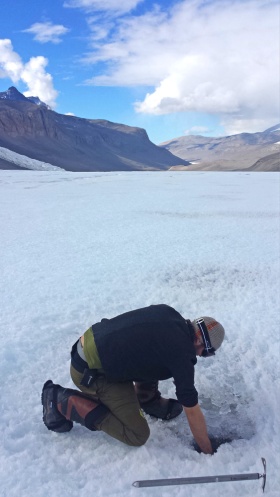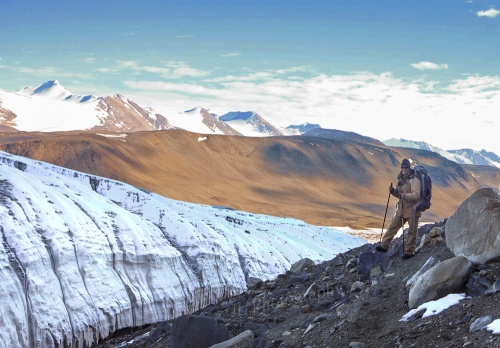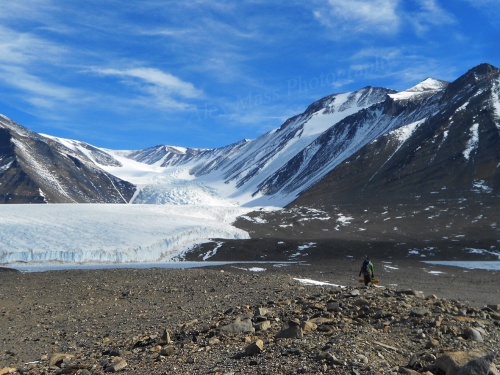Scaling Giants
Jan. 23, 2014
While I spent the first two months of my time here helping the Stream Team collect samples and measure flow levels of the creeks around Antarctica (and I’m working on a quick video to show what that’s like and our spectacular views from the field), in recent weeks I’ve been able to focus more on my own research, which takes place on glaciers.
 One of my fieldsites; Canada Glacier in the McMurdo Dry Valleys
One of my fieldsites; Canada Glacier in the McMurdo Dry Valleys
–
I’m researching the deposition of atmospheric halocarbon pollutants and a few other chemicals into glacial meltwater. Many halocarbons (compounds that contain chlorine, bromine, flourine, or iodine attached to carbon) are semi-volatile, which means that they are a gas when conditions are warm, but fall out of the atmosphere as a liquid or solid when temperatures are colder. This leads to a phenomenon called the ‘grasshopper effect‘ that leads to higher concentrations of these chemicals at the poles. In simple terms, what happens is this: gases like to spread out evenly in all directions. Think of it like filling a really large balloon with gas- the concentration of that gas will spread out everywhere in the balloon. But, unlike a balloon, Earth has different temperature conditions in different places, so when pollutants that are created in a place like the tropics start to spread out and reach a cold environment like a glacier, they condense into a liquid or solid form and fall out of the atmosphere, depositing onto the ice. However, the gas left IN the air will still continue to spread out and fill the ’empty’ space, causing even more of it to spread to the air above a glacier, condense into more liquid, and fall down to Earth’s surface. If that surface warmed up quite a lot during the summer, the gases could re-volatilize and phase back into gases to continue traveling around the world, but if the surface is always cold, it will act as a sink that causes more and more of a compound to ‘fall out’ of the atmosphere and pile up onto the icy surface. Thus around the world these chemicals ‘hop’ their way to colder and colder climates until they reach a place where they can’t get warm enough to ever hop back into a gaseous state again, becoming stuck in a cold place like Antarctica. (This is a simplification and only applies to certain chemicals, but is relevant for what I study.)
What this ultimately means is that many semi-volatile pollutants with long half-lives (chemicals that don’t degrade quickly) end up in cold regions very far away from the anthropogenic (man-made) sources that produced them. This also means that having chemicals reach cold climates and glaciers may have significant impacts on the quality of water in these regions. Since more than seventy percent of the world’s population gets their drinking water from glaciers and snowmelt (which contribute source water to rivers and streams), studying the types of contaminants that are attracted to and deposited in glacial areas is important to human health worldwide. Although Antarctica doesn’t have a large population of people drinking the glacial water, it’s a good place to study these chemicals and risks because I can get a clearer idea of where the chemicals came from (long-range chemical transport rather than local industry that pollutes an area), and from this information I can get a better idea of how the chemicals travel, deposit into water, and break down over time.
 Meltwater channels running through one of my fieldsites
Meltwater channels running through one of my fieldsites
–
In order to start my work, I’ve been hiking onto glaciers to get samples of the meltwater that collects in small pools on the glacial surface. I have to use very sensitive equipment in order to avoid contaminating the samples, since touching the water with my hands, clothing, or plastic would alter the results I’m able to measure.
 One of the melt holes I sampled on the glaciers, which is called a cryoconite
One of the melt holes I sampled on the glaciers, which is called a cryoconite
–
 Removing the tubing from another cryoconite
Removing the tubing from another cryoconite
–
Cryoconites form when dust and dirt fall onto a particular place the surface of the glacier, which lowers the albedo of the snow. Dirty (darker) snow absorbs more heat than white snow, so dirt that the wind blows onto a particular small area causes the snow around it to melt into a small hole like the ones pictured above. Once the hole has melted to 1-2ft deep, the dirt at the bottom no longer receives as much sunlight as the surrounding snow (because it is now under water), so it prevents the hole from growing any larger and you’re left with a series of small, shallow cryoconite holes of icy water that are spread out across a glacier in places where dirt once fell. These little holes are a good source to study how atmospheric chemicals deposit into exposed meltwater pools.
One of my favorite parts to this work is the ability to hike up the glaciers, getting phenomenal views of the Dry Valleys and Transantarctic mountains along the way. Granted, the hike up is a lot easier than the hike back when I’m carrying an extra 12 liters of sample water back with me to the lab.
 A few of the views while hiking towards the glaciers…
A few of the views while hiking towards the glaciers…
–
–
–
 For other glaciers, such as this trip to Taylor Glacier (the lower part of which contains Blood Falls, from my previous post), it’s too far to hike and instead we get dropped off on the top by helicopter
For other glaciers, such as this trip to Taylor Glacier (the lower part of which contains Blood Falls, from my previous post), it’s too far to hike and instead we get dropped off on the top by helicopter
–
 Carrying posts across the glacier
Carrying posts across the glacier
–
 The helicopter trips offer incredible views of the Transantarctic mountains from above
The helicopter trips offer incredible views of the Transantarctic mountains from above
–
On these first few trips I focused mostly on collecting meltwater samples from pockets on the various glaciers, but afterwards we went back to map out transects of the glacial surface. I’ll post about that next week.
Posted on 2014, in *Season 3: Life in the Dry Valleys, 2014 (01/23) Scaling Giants. Bookmark the permalink. 2 Comments.


Thank you for sharing your research and experiences up in Antarctica! The girls in my STEM program will also enjoy sharing in your adventures 🙂
Pingback: Antarctica’s Blood Red Waterfall | Tracing Knowledge ... Στα ίχνη της Γνώσης